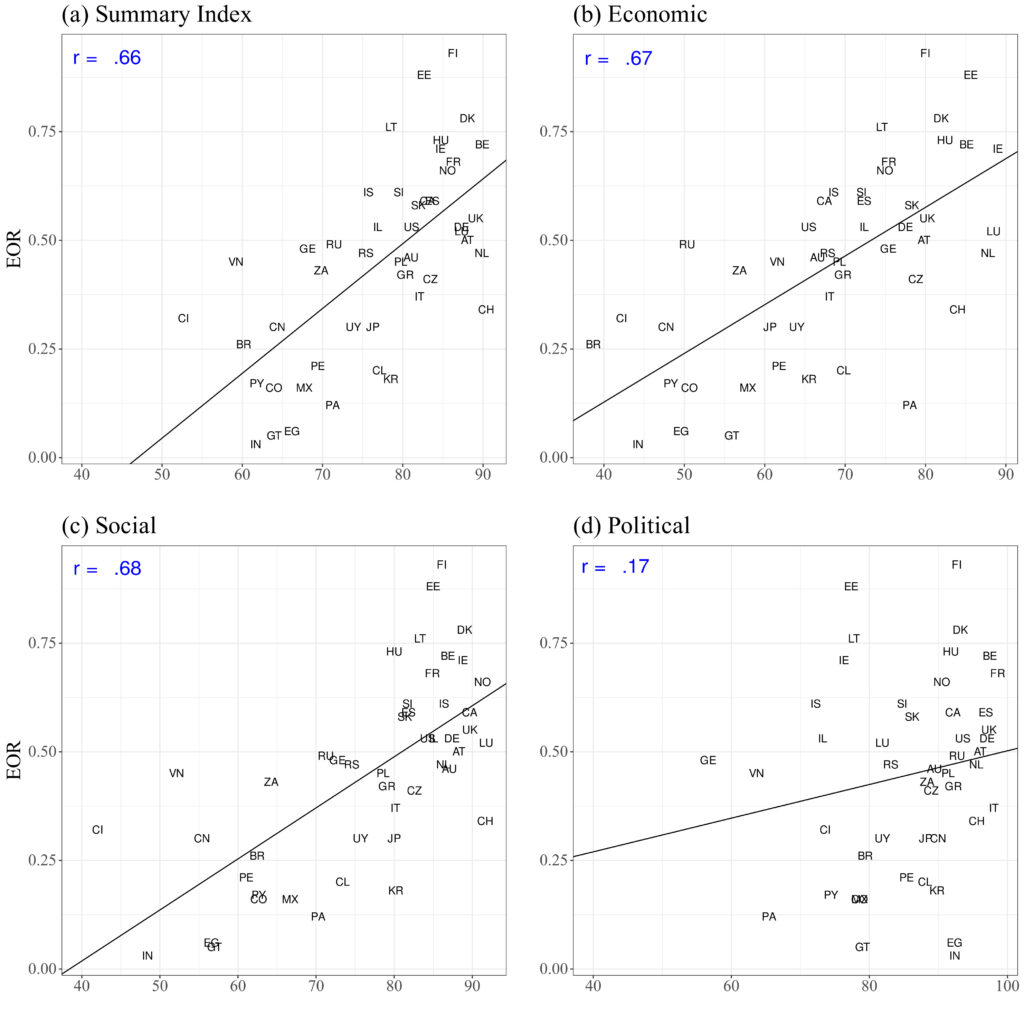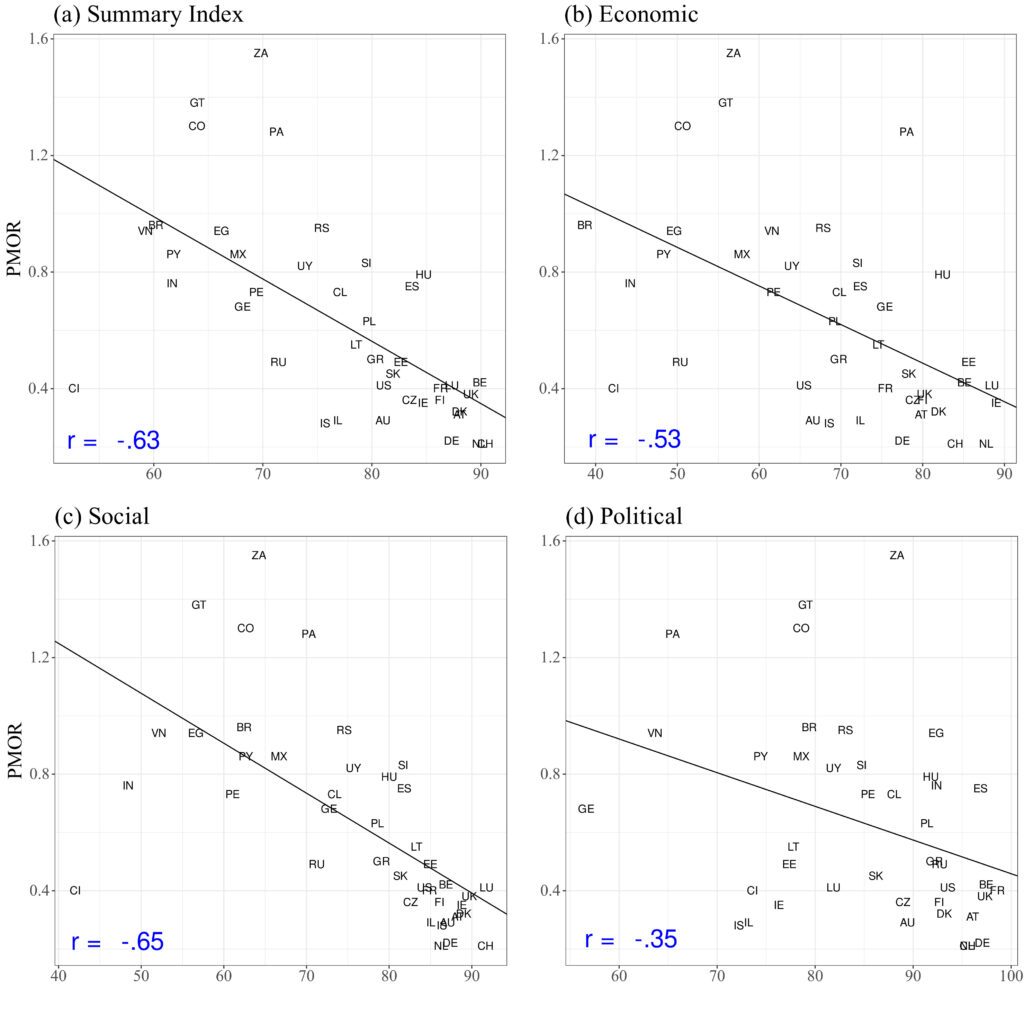The literature on globalization’s impact on women’s workforce participation generally takes a positive outlook but still produces mixed results. In their research, Yoav Roll, Moshe Semyonov, and Hadas Mandel indeed find that globalization, particularly its social dimensions, has spurred women labor participation but has not enabled women to secure high-paying jobs. To mitigate this occupational inequality, policymakers need to remove normative barriers that dissuade women from pursuing traditionally male-dominated roles, such as in STEM.
The number of women who have joined the cash economy and the range of occupations in which they work has increased since the 1950s across all nations. However, while women have increased their participation in the labor force, they are still outnumbered by men. In addition, the chances of women being employed in managerial and lucrative high-status positions remain lower than those of men in most countries. This is especially true when it comes to the most highly paid managerial positions.
Cross-country variations in female labor force participation and gender-linked occupational inequality are neither trivial nor random. These variations are associated with macro-level societal factors such as level of economic development, liberal perceptions, and welfare policy. In recent decades, globalization has also emerged as an influential factor affecting gender inequality across the world, especially inequality in the labor market.
Some scholars view globalization’s drive of economic competition as a liberating force. Such competition pushes businesses to maximize efficiency by hiring people and assigning them to jobs according to merit and skills, not on the basis of ascribed characteristics such as gender, leading to greater gender equality in the labor market.
Others warn of the negative effects of globalization. For example, scholars argue that increased reliance on international markets leads to a heightened vulnerability to trade shocks. Consequently, women’s work in the export-oriented industry – which has emerged in developing countries such as Bangladesh and Mexico – is highly precarious.
Globalization should not be viewed as just an economic phenomenon. It is social and political in nature, too. Indeed, at present times, countries are globally connected through networks of economic, social, and political organizations; sharing ideas, values, treaties, international organizations, and people. Thus, globalization results not only in an emergence of a global economy but also in a convergence of norms and laws across the world, in general, and with regard to gender equality, in particular.
Although researchers tend to agree that globalization helps propel women into the formal economy and the formal labor force, they have not reached consensus regarding the effect of globalization on the occupational attainments of men and women. In our work, we address two questions. First, does globalization increase women’s chance of being gainfully employed and, second, does globalization increase women’s chance of working in lucrative jobs (as compared to men)?
Our analysis is based on data from 47 countries, obtained from the Luxembourg Income Study (collected around 2013). Women’s labor force participation is defined by the relative representation of women in the economically active labor force in each country, and gender occupational inequality is defined as women’s relative representation in lucrative jobs: managerial and professional occupations in the upper 10% of income in each country. More specifically, using the KOF indices (as a measure of level of globalization in the country) we examined the extent to which globalization and its distinctive economic, social and political components are associated with higher levels of female labor force participation and greater chances for women to join lucrative positions.
Figure 1 shows the chances of women being gainfully employed (employment odds ratio, EOR) compared to men, by level of globalization in 47 countries. The figure reveals that, as expected, globalization and each of its components increases women’s relative chances of employment. The odds of women working are lowest in countries with low levels of globalization, such as India and Egypt (where they reach only 6% of the odds of men); and the highest in countries that rank high on the globalization index, such as the Nordic and Baltic countries, where women’s employment chances almost reach parity with men’s. Women’s employment chances are about half those of men in countries such as the United States, Germany, and Israel. It is important to note that, in contrast to the economic and social dimensions of globalization, the political dimension of globalization is only weakly related to female labor force participation.

Using Figure 2, it becomes apparent that globalization is also associated with women’s relative chances of being employed in lucrative-high status occupations (professional and managerial occupation odds-ratio, PMOR). However, unlike labor force participation, in the case of gender occupational inequality, women’s relative odds for employment in lucrative occupations tend to decrease, not to increase, with the level of globalization. The association is evident for the three dimensions of globalization: economic, social, and political. Apparently, when it comes to securing lucrative jobs, men seem to benefit more than women from globalization.
For example, in Finland and Estonia, where both globalization and women’s employment rates are high, women’s chances of working in highly paid professional and managerial positions are only 36% and 49% (respectively) of those of men. The relative chances of securing lucrative employment for working women in Egypt, where very few women are economically active and where globalization is quite limited, are 94% comparable to men’s. Although all three components of globalization are associated with women’s opportunities for attaining lucrative jobs, it becomes evident from Figure 2 that social globalization is correlated more strongly than the two other components with women’s occupational attainment.

At this point, it is reasonable to ask whether it is possible that the relationship between globalization and gender occupational inequality can be attributed to the shared relationships between globalization, gender-linked occupational inequality, and other societal-level attributes. One can suspect (as in the case of Egypt) that the association between globalization and gender occupational inequality is attributed to the low number of women participating in the economically active labor force. Possibly, as more women join the formal workforce as a result of globalization, they become a less selective group, and thus less likely to hold high-status lucrative positions.
By way of contrast, it is also possible that as more women join the economically active labor force, the pool of women to be channeled and allocated to traditional low-paying “female-type” jobs also increases. Therefore, it is reasonable to expect that in places where women constitute a large portion of the labor force, women’s relative odds for attaining “female-type” jobs are likely to increase and their relative odds for joining lucrative jobs are more likely to decrease. Curiously, further analysis accounting for people’s personal characteristics (such as their level of education) and country characteristics (such as the chances of women being employed in the first place in each country) does not lend firm support to these speculations. We found that even after taking into account differential selectivity into national labor markets, higher levels of globalization are still likely to increase gender occupational inequality.
To conclude, we found that globalization correlates with women’s ability to secure gainful employment. Nevertheless, they are not able to attain better access to the most lucrative occupations. In fact, the emergence of globalization may actually decrease women’s relative chances of obtaining the lucrative high-status managerial and professional positions. Furthermore, we found that women’s experience of globalization is more driven by the consequences of social globalization than economic and political globalization. We suggest therefore that change in norms, increased communication, and interconnectedness among nations is likely to increase female labor force participation but not the patterns of occupational inequality between men and women.
We can only speculate why social globalization has a negative effect on women’s ability to obtain the most lucrative employment opportunities. It is possible that the effects of globalization on women’s opportunities in the labor market can be attributed to the propagation of individualism at a global level, the process by which persons express their true self through their choice of occupation, coupled with the persistence of the belief in gender essentialism. As a consequence of social globalization, women are encouraged to pursue education and a career. In spite of this, their choice of occupation may still be influenced by traditional gender roles, representing a perceived true self. A result of this is that women may choose to pursue education and occupations that conform to their gender stereotypes rather than the most lucrative managerial and professional occupations. Policymakers should strive to remove ingrained perceptions that certain occupations are more masculine or feminine. Not only will this enable everyone to achieve their full potential, but it will also allow employers to recruit the most qualified candidates to positions without prejudice and regardless of the gender of the candidate.
Articles represent the opinions of their writers, not necessarily those of the University of Chicago, the Booth School of Business, or its faculty.






